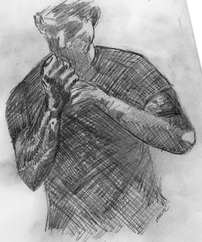I arc my two hands (crane beaks formed with each) in a tight circle pulling down and towards me. My forearms and "beaks" contact their forearms and draw them forward and down into my right inward elbow and left horizontal palm strike that "sandwiches" their head (leaving them in a pickle?).
This circle was a continuation of the clearing circle. This immediate elbow and palm also serve as a preventive defense of the head butt. This is all accomplished while stepping forward with the right foot in a right neutral bow with my right foot strategically placed between their legs.
I strike vertically down with a right tiger's claw (breaking the nose with the palm and tearing at the face with the fingers) followed immediate by a right front scoop kick (to the groin). I plant back into a left neutral bow from which I follow up with a right front thrust kick to opponent's chest.
The technique uses the crane (clear with crane beak hands and then elbow them in the head with your wing) to defeat the snake (grabbing).
Lesson One: We are lucky! This guy attacked us from the front with all of his hand weapons and all he did was grab us on the shirt. We could have been punched, our face clawed, pushed on our rear, or choked at least.
Lesson Two: "Frictional Pull." By contacting at the forearm near the elbow and then dragging our hands diagonally down all the way to their wrists, this contact drags our opponent down and in towards us and encourages also the release of their grip.
Lesson Three: "Accidental Movements." Murphy's Law "anything the can go wrong will go wrong" is especially true when you are having one of those days where somebody decides to try to beat you up. As we clear their grip we need to be aware that this may encourage an accidental head butt on their part to our nose. This accidental move is checked by our elbow and palm strike which is not only a strike but a defense against this accidental move. However, if your timing is delayed in delivering this "sandwich" then you might wake up with a broken nose wondering what just happened.
Lesson Four: "Anchored Elbows." When our elbows point down we increase our leverage compared to our elbows pointing out. This anchors our power by improving body alignment to work with the pulling motion of the shoulder with correct mechanical efficiency. The initial clearing motion often suffers from students flaring their elbows out and negating the "anchored elbow" principle.
Lesson Five: "Rebounding." Rebounding is often used when our strike bounces off our own body to preserve momentum so that we can apply more force and greater expediency in our follow up strike. If our opponent does not let go after our clear attempt, do not force the issue but instead allow their hold to be a tether that keeps them their as a human pinata for our elbow strike that simply rebounds off of their grip into their head. Incidentally, rebounding is also used in this technique after our scoop kick to the groin; our right foot rebounds off the ground immediately into the front kick to our opponent's chest.
Additional Tips:
1. This technique has excellent flow when timed correctly. However, often in trying to do the technique to quickly students "race to the red light" to stop and then race to the next red light. Slow it down and gradually speed up the movements to understand how your clear flows into the elbow/palm sandwich and how the scoop kick happens interwoven with the tigers claw as you retreat.
2.Watch your posture. It is not necessary to bend forward when clearing. This further exposes you to a head butt and takes away from the transfer of energy downward into your stance on the clear.
Methods of Drill:
1. Change the timing of engagement:
a) They have a hold of you already (the assumption of the original technique).
b) You clear as they are reaching to grab you.
c) You close in and clear their guard and apply the technique preemptively.
d) They grab and extend arms forcing you to step back and apply the technique.
2. Use a heavy bag to practice all of the strikes (except the scoop kick) to work the power and follow through of each fundamental.
3. Diversify the application by changing the attacks. A single lapel grab right, single lapel grab left, two hand push attempt, right straight punch, and left straight punch are all quite applicable attacks for this technique.
What's in a name? "Converging Wings" refers to the right inward elbow (wing) that meets up with the left horizontal palm (wing like...) on your opponent's head. The circle begins with the clear and then converge on the sandwiching elbow/palm strike.

 RSS Feed
RSS Feed